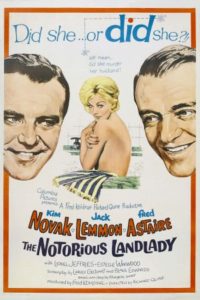“Are you sure this country isn’t on fire somewhere?” —— “Bill” Gridley (Jack Lemmon) inquiring about the thickness of a London fog
Jack Lemmon. Kim Novak. Fred Astaire. And the British, too. Lionel Jeffries. Estelle Winwood. Henry Daniell. A London setting. A mystery-comedy about a gorgeous landlady who might, or might not, have killed her husband. A perfect blend, then, of murder, mystery and comedy, the makings of a rambunctious, rollicking, uproarious, spine-tingling, hilarious movie?— Well . . . Slow down the tempo, remove the potential for numerous laughs, make the humor a little muddled, ignore some basic points of good mystery writing, over-complicate the plot a bit and, then, at the end, accelerate from the previous leisurely adagio tempo (when some viewers might have dozed off), to a manic, slapstick, through-the-park-and-down-the-hill chase, with a wheelchair, no less—and you have the final product, The Notorious Landlady from 1962.
Not to say, on the other hand, that there isn’t some merit in going out of the way to see this movie. There is the obvious delight in the mere presence of the major stars—not to go, now, the other direction and overstate the film’s good qualities, against those reservations already mentioned. It’s questionable that star quality alone is enough to sustain any movie. In this case, it’s up to someone who has sat through the film.
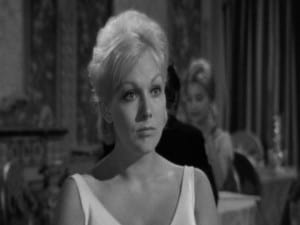 Director Robert Quine (The Solid Gold Cadillac, The World of Suzie Wong) seems content to give little guidance in helping his stars surmount, escape, if necessary, their usual screen personas. This though is, after all, not high drama, and here appropriate “high” acting is less important, even if many say good acting is always a prerequisite for any endeavor, stage or screen. Lemmon remains the reliable, happy-go-lucky fellow, the comic figure of so many other Lemmon films. Here his exuberance is allowed too often to go over the top.
Director Robert Quine (The Solid Gold Cadillac, The World of Suzie Wong) seems content to give little guidance in helping his stars surmount, escape, if necessary, their usual screen personas. This though is, after all, not high drama, and here appropriate “high” acting is less important, even if many say good acting is always a prerequisite for any endeavor, stage or screen. Lemmon remains the reliable, happy-go-lucky fellow, the comic figure of so many other Lemmon films. Here his exuberance is allowed too often to go over the top.
As expected among the list of stars—and it is tempting to linger here!—the most eye-fetching is Novak, though she has appeared more luscious earlier, in Picnic, The Eddy Duchin Story and, perhaps most luscious of all, in Bell, Book and Candle (also directed by Quine), despite Robert Burks’ attentive close-ups in Vertigo. These four films signaled the peak of Kim’s career, all coming in a relatively brief four-year span, 1955 to 1958. Her short time on top, and her rather rapid decline, would be sadly caricatured in her role as one of two bickering, faded movie stars—the other played by Elizabeth Taylor—in a slightly better mystery, The Mirror Crack’d (1980).
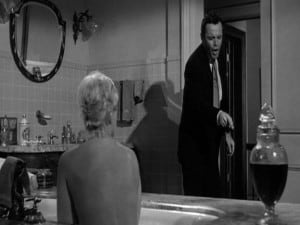 In The Notorious Landlady, Novak endures, attractive enough though, typically somehow a little artificially seductive, as from a distance, as in so many of her attempts to radiate allure. The TV reporter Harry Reasoner once referred to Ingrid Bergman, for example, as “licentious and demure,” a dual blend that helped make her an icon, a quality that Novak tries to achieve but which is quite beyond her. In one scene, Novak is in a bathtub, her back discreetly to the camera, when Lemmon enters. Strangely, she emits no allure, no magic and is obviously uncomfortable in the scene; and, to match her, Lemmon shows no curiosity, no sneaked peeks, almost embarrassed, as if he has walked in on his aged grandmother.
In The Notorious Landlady, Novak endures, attractive enough though, typically somehow a little artificially seductive, as from a distance, as in so many of her attempts to radiate allure. The TV reporter Harry Reasoner once referred to Ingrid Bergman, for example, as “licentious and demure,” a dual blend that helped make her an icon, a quality that Novak tries to achieve but which is quite beyond her. In one scene, Novak is in a bathtub, her back discreetly to the camera, when Lemmon enters. Strangely, she emits no allure, no magic and is obviously uncomfortable in the scene; and, to match her, Lemmon shows no curiosity, no sneaked peeks, almost embarrassed, as if he has walked in on his aged grandmother.
Novak’s first appearance in Landlady, however, is possibly her most effective bit of acting, while at the same time she becomes a bit cheekily mysterious, posing as a cockney maid as she peeks through a gap in a nearly-closed door when Lemmon first inquires about a room at her flat.
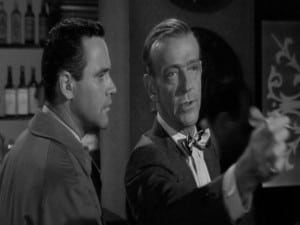 Astaire, even away from the dance floor, radiates the same charm as in Top Hat and Royal Wedding, apparently willing, more certainly than Novak, to discard all caution and fall in with the light-hearted aspects of Landlady, at one point falling into a freshly dug, heretofore unoccupied, grave. If none of his potential as a serious actor shows here, it had been demonstrated a few years earlier in On the Beach, as a scientist and race driver, and, at one point, travels to doomsday, the theme of that film, in a submarine of all things, as far, perhaps, from the dance floor as conceivable.
Astaire, even away from the dance floor, radiates the same charm as in Top Hat and Royal Wedding, apparently willing, more certainly than Novak, to discard all caution and fall in with the light-hearted aspects of Landlady, at one point falling into a freshly dug, heretofore unoccupied, grave. If none of his potential as a serious actor shows here, it had been demonstrated a few years earlier in On the Beach, as a scientist and race driver, and, at one point, travels to doomsday, the theme of that film, in a submarine of all things, as far, perhaps, from the dance floor as conceivable.
The film’s pluses include some excellent black-and-white photography by Arthur E. Arling, Oscar-winner for The Yearling, also known for two other color films, Captain from Castile (along with two co-directors) and Pillow Talk. The cinematography is especially effective in the night scenes—the shadowy streets, the ever-present London fog, the dark interiors of Novak’s flat and the various individuals creeping about.
 The somewhat weak humor, and that it falls short of achieving its potential with the right amount of punch, is hard to explain, considering this was Larry Gelbart’s first motion picture screenplay, co-written with Blake Edwards. Maybe because it was his first or was unfavorably influenced by Edwards? Gelbart had been doing television since The Colgate Comedy Hour and his work with Sid Caesar in the ’50s. By far his supreme and best-remembered work came with the TV series M*A*S*H, 1972-1984, an altogether different kind of humor, and, with the foibles of the military, a greater source, and broader palette, for laughs.
The somewhat weak humor, and that it falls short of achieving its potential with the right amount of punch, is hard to explain, considering this was Larry Gelbart’s first motion picture screenplay, co-written with Blake Edwards. Maybe because it was his first or was unfavorably influenced by Edwards? Gelbart had been doing television since The Colgate Comedy Hour and his work with Sid Caesar in the ’50s. By far his supreme and best-remembered work came with the TV series M*A*S*H, 1972-1984, an altogether different kind of humor, and, with the foibles of the military, a greater source, and broader palette, for laughs.
The musical score, credited to George Duning, is basically George Gershwin’s “A Foggy Day (In London Town).” Used subtly but too sparingly, and with little imagination, it most often accompanies romantic moments between Lemmon and Novak, and the night street scenes, with all that fog. That frantic finale mentioned is supported by tunes from The Pirates of Penzance by Arthur Sullivan; no words from his lyricist William S. Gilbert are heard here.
The plot, on the surface, seems simple enough, but it has its convolutions and unnecessary deviations. William Gridley (Lemmon) arrives from Saudi Arabia at his new job at the American Embassy in London. His boss, Franklyn Ambruster (Astaire), asks if Gridley has a good place to stay. Yes, in Mayfair; he’s already rented rooms at Mrs. “Carly” Hardwicke’s (Novak) flat. She’s from Chicago. And Ambruster advises him to “keep your off hours tidy.”
 Gridley learns that Carly might have killed her British husband—no body found, so nothing conclusive and the police haven’t a case. Still, makes one wonder. Ambruster learns about the rumor and asserts that Gridley has used poor judgment in renting rooms at her place. “You’re at a level,” Ambruster warns, “where you can only afford one mistake. . . . Right at the top, if you make enough of them, it’s considered to be your style.” Very quickly, Gridley falls in love with Carly, believing—or is he just convincing himself that she’s innocent—and immediately they’re out dining and dancing.
Gridley learns that Carly might have killed her British husband—no body found, so nothing conclusive and the police haven’t a case. Still, makes one wonder. Ambruster learns about the rumor and asserts that Gridley has used poor judgment in renting rooms at her place. “You’re at a level,” Ambruster warns, “where you can only afford one mistake. . . . Right at the top, if you make enough of them, it’s considered to be your style.” Very quickly, Gridley falls in love with Carly, believing—or is he just convincing himself that she’s innocent—and immediately they’re out dining and dancing.
One night out, they’re approached on the street by a cloaked stranger (Daniell) who asks to speak to Carly—a red herring, as he will later prove to be a benevolent priest.
Scotland Yard inspector Oliphant (Jeffries) asks Gridley to spy on Carly without her knowing it, of course. During a grilling of steaks on Carly’s patio, the flames spread to a canopy and firemen are called, causing a scandal in the newspapers. It doesn’t look good for Gridley, so Carly goes to the embassy to plead his case.
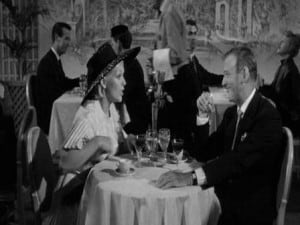 When Ambruster later has lunch with Carly, he, too, is smitten with her and believes her innocent.
When Ambruster later has lunch with Carly, he, too, is smitten with her and believes her innocent.
Carly’s long-missing husband Miles (Maxwell Reed) appears and wants the pawn ticket. Yes, Carly says, she knows about it, but doesn’t have it. There is a struggle when Miles threatens her with a gun and he is accidentally shot. Carly is put on trial for his murder, and due to the eyewitness of the nurse, Agatha Brown (Philippa Bevans), to a wheelchair-bound old lady, Mrs. Dunhill (Winwood), she is exonerated.
It’s not so simple, however. Carly was being blackmailed by Brown for the pawn ticket to a candelabra, inside of which is some stolen jewelry, hidden by Miles. When Gridley and Carly arrive at the pawn shop to retrieve the item, the pawnbroker is found murdered by Brown, who has fled with Mrs. Dunhill to Penzance in Cornwall on the English Channel, with Gridley and Carly pursuing in a car.
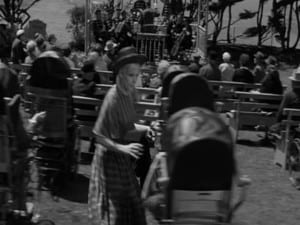 Following in a police helicopter are Ambruster and Oliphant. During a band concert in the park overlooking the sea, Gridley and Carly dash among the countless parked wheelchairs, peering under the canopies, which all the wheelchairs seem to have. The two see the tracks of a recent wheelchair and spot Brown pushing Mrs. Dunhill up a hill. They give chase.
Following in a police helicopter are Ambruster and Oliphant. During a band concert in the park overlooking the sea, Gridley and Carly dash among the countless parked wheelchairs, peering under the canopies, which all the wheelchairs seem to have. The two see the tracks of a recent wheelchair and spot Brown pushing Mrs. Dunhill up a hill. They give chase.
While Carly and Brown tussle, repeatedly knocking each other down and rolling in the dirt, Gridley chases after the lone wheelchair, now rolling down the hill and across a footbridge toward the edge of a cliff. Gridley catches it just in time and Carly knocks the breath out of Brown with a headbutt.
All of this to source music, supposedly, from the band in the park, playing lively tunes from The Pirates of Penzance, including “I Am the Very Model of a Modern Major-General” and “With Cat-Like Tread” (known in the U.S. as “Hail, Hail, the Gang’s All Here”).
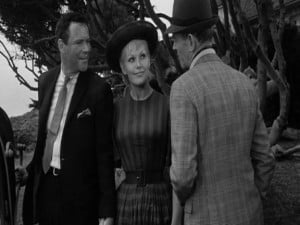 Ambruster asks Gridley if he would like to return to the U.S. on an assignment, and he and Carly think that’s great. Mrs. Dunhill, unattended and still in her wheelchair, is rolling away once again down the hill. Everyone, after her! The final shot of the movie is of the bandstand. Was the wheelchair caught a second time? Who knows.
Ambruster asks Gridley if he would like to return to the U.S. on an assignment, and he and Carly think that’s great. Mrs. Dunhill, unattended and still in her wheelchair, is rolling away once again down the hill. Everyone, after her! The final shot of the movie is of the bandstand. Was the wheelchair caught a second time? Who knows.
Although Lionel Jeffries had his dramatic and straight parts, he is best remembered, at least by this admirer, as one of the master eccentrics of the screen. As Joseph Cavor he is the befuddled scientist who invents a space ship and its coating, called cavorite, to reflect gravity in First Men in the Moon; the easily exasperated Captain Sydney Phumstone in one of the Margaret Rutherford/Miss Marple mysteries, Murder Ahoy; and Grandpa Potts, another crazy inventor, in Chitty Chitty Bang Bang. Like one half of Ingrid Bergman’s dual quality, Jeffries is rather demure in Landlady, with little opportunity for comic display. It’s a pity that the big screen was largely deprived of his caricatures when he went into television in 1980.
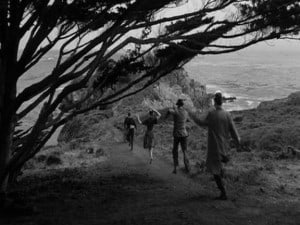 To end on a comic note regarding The Notorious Landlady, this comedy or possibly strained comedy, there is the unlucky TV premiere on CBS’ Thursday Night at the Movies in 1965. The film’s reels were shown out of order, up until a point when an alert someone called in. It’s unknown if some TV viewers who had previously seen the movie in the theater called in, to say to leave the reels alone, that the changes had made an improvement.
To end on a comic note regarding The Notorious Landlady, this comedy or possibly strained comedy, there is the unlucky TV premiere on CBS’ Thursday Night at the Movies in 1965. The film’s reels were shown out of order, up until a point when an alert someone called in. It’s unknown if some TV viewers who had previously seen the movie in the theater called in, to say to leave the reels alone, that the changes had made an improvement.
